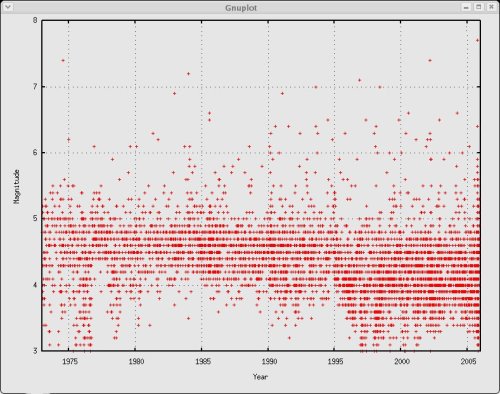
| MadSci Network: Earth Sciences |
Nora,
The number of aftershocks from the October 8'th event has not been unusually excessive. The larger the initial earthquake, the more aftershocks there are.
The size and number of aftershocks are described reasonably well by the Gutneburg-Richter frequency magnitude relation and the Omori law. Both are empirical relations. (People collected data and tried to fit reasonable functions to them.)
The Gutenburg-Richter relation is:
N = a - b * M
where:
N is the number of events of magnitude M and above
a and b are values that are adjusted to fit the data
a typically is on the order of 6 and b is around 1.
The Omori law fits the number of events as a function of time. The initial form of the law was a 1/t decay. Recent work indicates the time should be raised to a power that depends on the magnitude of the main earthquake and the number of nearby faults. Lower magnitudes have a lower power which means the aftershock sequence lasts relatively longer than for larger earthquakes. This may seem odd, but smaller earthquakes have fewer aftershocks and larger ones shake up larger areas. Aftershock sequences for large earthquakes can last for years.
I went to the National Earthquake Information Center and extracted the earthquake list for the period from January 1, 1973 to December 1, 2005 within 500 kilometers of the October 8'th earthquake.

Of the 6895 located earthquakes, 7 were magnitude 7 and above, 47 were from 6.0 to 6.9 and 470 were from 5.0 to 5.9.
The figure shows a couple of things. The first, most obvious and inconsequential is that earthquakes are reported to the nearest 0.1 magnitude. (The figure looks banded.) Another point is that the number of magnitude 4 to 5.5 earthquakes has been relatively constant from year to year. Also, the number of well located smaller earthquakes has varied over this period. Smaller earthquakes require relatively close recording stations to get good locations. This requirement is frequently met by portable seismic stations.
David
There are several web sites that you may find interesting:
Iris Seismic Monitor - A personal favorite. I check it nearly every day.
Try the links in the MadSci Library for more information on Earth Sciences.